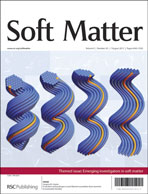Complexation between weakly basic dendrimers and linear polyelectrolytes: effects of grafts, chain stiffness, and pOH
Abstract
We develop and implement a new hybrid methodology combining self-consistent field theory (SCFT) and Monte Carlo simulations to study the complexation between negatively charged semiflexible linear polyelectrolyte (LPE) molecules and a positively charged dendrimer containing grafts of neutral polymers. We examine the influence of LPE stiffness, length of the dendrimer grafts, and solution pOH upon the characteristics of the resulting complexes. Our results indicate that increasing LPE stiffness reduces the dendrimer–LPE binding affinity and results in an overall higher net charge carried within the dendrimer molecule. When we varied the size of the grafts, the dendrimer–LPE binding strength was seen to decrease with increasing grafting chain length for the flexible LPE chains. In contrast, for stiff LPE chains, the binding strength was not seen to vary significantly with the grafting lengths. Overall, longer grafting lengths were seen to reduce the fraction of exposed LPE molecules, suggesting that grafted dendrimers may better shield nucleic acid material from serum nucleases. Lastly, we found that increasing the solution pOH was seen to enhance both the binding between the dendrimer and LPE molecules and the total positive charge carried by the complex.

- This article is part of the themed collection: Emerging Investigators

 Please wait while we load your content...
Please wait while we load your content...